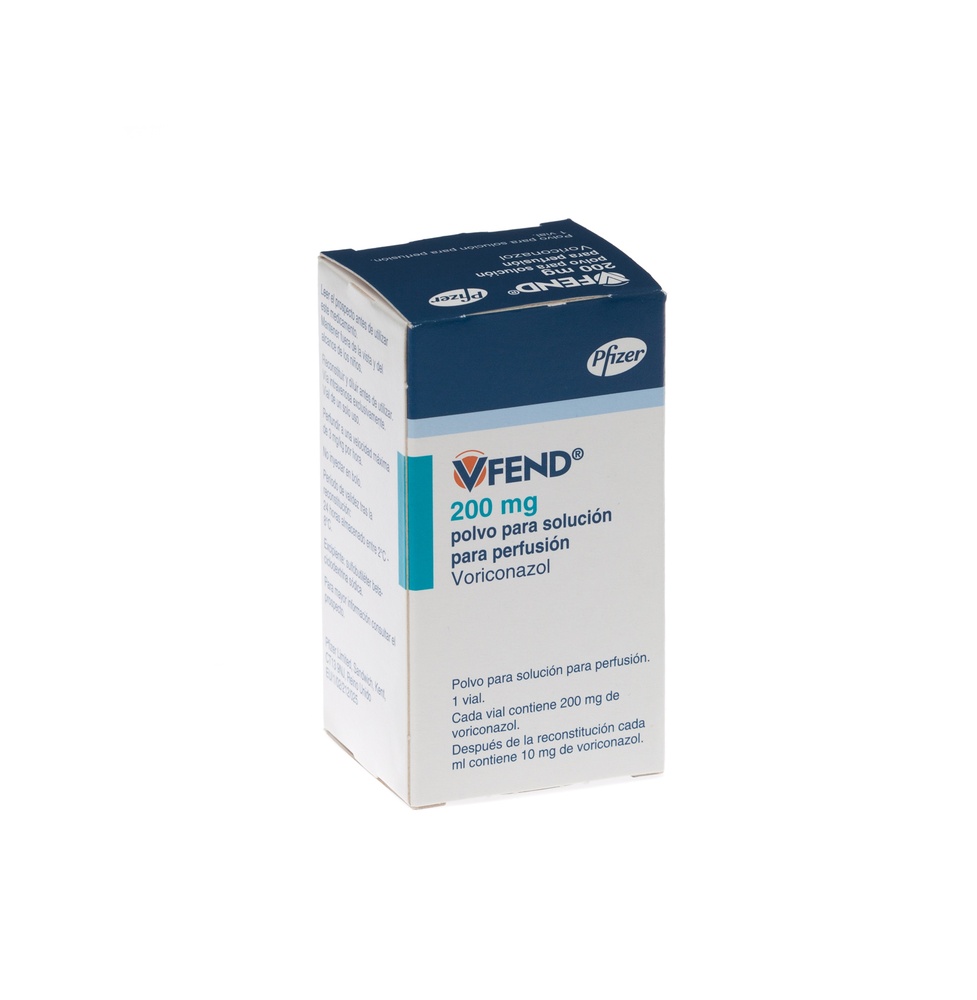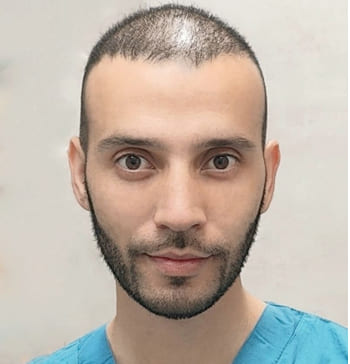

ВФЕНД 200 мг ПОРОШОК ДЛЯ ПРИГОТУВАННЯ РОЗЧИНУ ДЛЯ ІНФУЗІЙ

Запитайте лікаря про рецепт на ВФЕНД 200 мг ПОРОШОК ДЛЯ ПРИГОТУВАННЯ РОЗЧИНУ ДЛЯ ІНФУЗІЙ

Інструкція із застосування ВФЕНД 200 мг ПОРОШОК ДЛЯ ПРИГОТУВАННЯ РОЗЧИНУ ДЛЯ ІНФУЗІЙ
Введення
Опис: інформація для користувача
VFEND200мг порошок для інфузійного розчину
воріконазол
Прочитайте уважно весь опис перед початком використання препарату, оскільки він містить важливу інформацію для вас.
- Збережіть цей опис, оскільки вам може знадобитися знову його прочитати.
- Якщо у вас виникли питання, проконсультуйтеся з вашим лікарем, фармацевтом або медсестрою.
- Цей препарат призначений тільки для вас і не слід давати його іншим людям, навіть якщо вони мають相同ні симптоми, оскільки це може їм зашкодити.
- Якщо ви відчуваєте побічні ефекти, проконсультуйтеся з вашим лікарем, фармацевтом або медсестрою, навіть якщо це побічні ефекти, які не вказані в цьому описі. Див. розділ 4.
Зміст опису
- Що таке VFEND і для чого він використовується
- Що потрібно знати перед початком використання VFEND
- Як використовувати VFEND
- Можливі побічні ефекти
- Зберігання VFEND
- Зміст упаковки та додаткова інформація
1. Що таке VFEND і для чого він використовується
VFEND містить активну речовину воріконазол. VFEND є антимікотичним препаратом. Він діє шляхом знищення або запобігання росту грибків, які викликають інфекції.
Він використовується для лікування пацієнтів (дорослих і дітей віком від 2 років і старших) з:
- інвазивною аспергілозою (тип грибкової інфекції, викликаний Aspergillus sp),
- кандидемією (інший тип грибкової інфекції, викликаний Candida sp) у пацієнтів, які не мають нейтропенії (пацієнтів, які не мають аномально низького рівня лейкоцитів),
- важкими інвазивними інфекціями, викликаними Candida sp, коли гриб стійкий до флуконазолу (інший антимікотичний препарат),
- грибковими інфекціями, викликаними Scedosporium spабо Fusarium sp(два різних види грибків).
VFEND використовується у пацієнтів з важкими грибковими інфекціями, які можуть загрожувати життю.
Профілактика грибкових інфекцій у пацієнтів, які перенесли трансплантацію кісткового мозку з високим ризиком.
Цей препарат слід використовувати тільки під медичним наглядом.
2. Що потрібно знати перед початком використання VFEND
Не використовуйте VFEND
якщо ви алергічні на воріконазол або сульфобутілетер β-циклодекстрин натрію (включено в розділ 6).
Це дуже важливо, щоб ви повідомили вашому лікареві або фармацевту, якщо ви використовуєте або нещодавно використовували інші препарати, навіть ті, які можна придбати без рецепта, або лікарські рослини.
Під час лікування VFEND не слід приймати наступні препарати:
- Терфенадин (використовується для лікування алергії).
- Астемізол (використовується для лікування алергії).
- Цисаприд (використовується для лікування проблем з травленням).
- Пімозид (використовується для лікування психічних розладів).
- Хінідин (використовується для лікування серцевих аритмій).
- Івабрадин (використовується для лікування симптомів хронічної серцевої недостатності).
- Рифампіцин (використовується для лікування туберкульозу).
- Ефавіренз (використовується для лікування ВІЛ) у дозі 400 мг і вище один раз на добу.
- Карбамазепін (використовується для лікування епілепсії).
- Фенобарбітал (використовується для лікування важкої безсонливості та епілепсії).
- Ерготамічні алкалоїди (наприклад, ерготамін, дігідроерготамін; використовуються для лікування мігрені).
- Сиролімус (використовується у пацієнтів, які перенесли трансплантацію).
- Ритонавір (використовується для лікування ВІЛ) у дозі 400 мг і вище двічі на добу.
- Золотий корінь (гіперicum, лікарська рослина).
- Налоксегол (використовується для лікування запору, викликаного опіоїдами [наприклад, морфіном, оксикодоном, фентанілом, трамадолом, кодеїном]).
- Толваптан (використовується для лікування гіпонатремії [низького рівня натрію в крові] або для сповільнення погіршення функції нирок у пацієнтів з полікістозом нирок).
- Лурасидон (використовується для лікування депресії),
- Венетоклакс (використовується для лікування пацієнтів з хронічною лімфоцитарною лейкемією [ХЛЛ]).
Попередження та застереження
Проконсультуйтеся з вашим лікарем, фармацевтом або медсестрою перед початком використання VFEND, якщо:
- ви мали алергічну реакцію на інші азоли.
- ви страждаєте або страждали раніше від якоїсь хвороби печінки. Якщо ви страждаєте від хвороби печінки, ваш лікар може призначити вам нижчу дозу VFEND. Ваш лікар також повинен контролювати функцію вашої печінки під час лікування VFEND шляхом проведення аналізів крові.
- ви знаєте, що страждаєте від кардіоміопатії, нерегулярних серцевих скорочень, повільного серцевого ритму або аномалії на електрокардіограмі (ЕКГ), яку називають «пролонгованим синдромом QTc».
Ви повинні уникати будь-якого впливу сонячного світла та ультрафіолетового випромінювання під час лікування. Це важливо, щоб ви захищали відкриті ділянки шкіри та використовували сонцезахисний крем з високим ступенем захисту, оскільки може виникнути підвищена чутливість шкіри до ультрафіолетового випромінювання сонця. Це може бути посилено при використанні інших препаратів, які підвищують чутливість шкіри до сонячного світла, таких як метотрексат. Ці заходи також застосовуються до дітей.
Під час лікування VFEND:
- повідомте вашому лікареві, якщо у вас виникнуть
- сонячний опік
- важка шкірна висипка або пухирі
- біль у кістках
Якщо ви розвиваєте шкірні розлади, такі як описані вище, ваш лікар може направити вас до дерматолога, який після консультації може вважати важливим регулярно обстежувати вас. Існує мала ймовірність того, що ви розвинете рак шкіри при тривалому використанні VFEND.
Якщо ви розвиваєте ознаки «недостатності наднирників» у вигляді симптомів, таких як хронічна втома або тривала слабкість, м'язова слабкість, зниження апетиту, втата ваги, біль у животі, повідомте вашому лікареві.
Якщо ви проявляєте ознаки «синдрому Кушинга» у вигляді симптомів, таких як набір ваги, жировий горб між плечима, округле обличчя, потемніння шкіри живота, стегон, грудей і рук, тонка шкіра, легко утворення синяків, високий рівень цукру в крові, надмірний рост волосся або надмірна пітливість, повідомте вашому лікареві.
Ваш лікар повинен контролювати функцію вашої печінки та нирок шляхом проведення аналізів крові.
Діти та підлітки
VFEND не слід застосовувати у дітей молодших 2 років.
Інші препарати та VFEND
повідомте вашому лікареві або фармацевту, якщо ви приймаєте, нещодавно приймали або можете приймати інші препарати.
- Деякі препарати, які використовуються одночасно з VFEND, можуть впливати на дію VFEND або VFEND може впливати на дію інших препаратів.
повідомте вашому лікареві, якщо ви використовуєте наступні препарати, оскільки одночасне лікування з VFEND слід уникати, якщо це можливо:
- Ритонавір (використовується для лікування ВІЛ) у дозі 100 мг двічі на добу.
- Гласдегіб (використовується для лікування раку); якщо вам потрібно використовувати обидва препарати, ваш лікар буде часто контролювати ваш серцевий ритм.
повідомте вашому лікареві, якщо ви використовуєте будь-який з наступних препаратів, оскільки лікування одночасно з VFEND слід уникати, якщо це можливо, і може знадобитися корекція дози воріконазолу:
- Рифабутин (використовується для лікування туберкульозу). Якщо ви вже приймаєте рифабутин, буде потрібно контролювати ваш аналіз крові та побічні ефекти рифабутину.
- Фенітойн (використовується для лікування епілепсії). Якщо ви вже приймаєте фенітойн, буде потрібно контролювати рівень фенітойну в вашій крові під час лікування VFEND і може знадобитися корекція дози.
повідомте вашому лікареві, якщо ви приймаєте будь-який з наступних препаратів, оскільки може знадобитися корекція дози або контроль для підтвердження того, що ці препарати та/або VFEND продовжують діяти:
- Варфарин та інші антикоагулянти (наприклад, фенпрокумон, аценокумарол; використовуються для зниження згортання крові).
- Циклоспорин (використовується у пацієнтів, які перенесли трансплантацію).
- Такролімус (використовується у пацієнтів, які перенесли трансплантацію).
- Сульфонілурети (наприклад, толбутамід, гліпізид і глібурід) (використовуються для лікування цукрового діабету).
- Статини (наприклад, аторвастатин, симвастатин) (використовуються для зниження рівня холестерину).
- Бензодіазепіни (наприклад, мідазолам, тріазолам) (використовуються для лікування важкої безсонливості та стресу).
- Омепразол (використовується для лікування виразкової хвороби шлунка).
- Оральні контрацептиви (якщо ви використовуєте VFEND під час прийому оральних контрацептивів, ви можете відчувати побічні ефекти, такі як нудота та порушення менструального циклу).
- Алкалоїди барвінку (наприклад, винкристин і винбластин) (використовуються для лікування раку).
- Інгібітори протеази ВІЛ (використовуються для лікування інфекції ВІЛ).
- Інгібітори тирозинкінази (наприклад, аксітиніб, бозутиніб, кабозантиніб, церитиніб, кобіметиніб, дабрафеніб, дасатиніб, нілотиніб, сунітиніб, ібрутиніб, рибоцікліб) (використовуються для лікування раку).
- Третіноїн (використовується для лікування лейкемії).
- Інгібітори зворотної транскриптази ненуклеозидного типу (наприклад, ефавіренз, делавірдін і невірапін) (використовуються для лікування інфекції ВІЛ) (декілька доз ефавіренза НЕ слід приймати одночасно з VFEND).
- Метадон (використовується для лікування залежності від героїну).
- Альфентаніл, фентаніл та інші опіоїди короткої дії, такі як суфентаніл (анальгетики, які використовуються під час операцій).
- Оксикодон та інші опіоїди тривалої дії, такі як гідрокодон (використовуються для лікування помірного до важкого болю).
- Нестероїдні протизапальні препарати (наприклад, ібупрофен, диклофенак) (використовуються для лікування болю та запалення).
- Флуконазол (використовується для лікування грибкових інфекцій).
- Еверолімус (використовується для лікування раку нирок та пацієнтів, які перенесли трансплантацію).
- Летермовір (використовується для профілактики інфекції цитомегаловірусом (ЦМВ) після трансплантації кісткового мозку).
- Івакафтор: використовується для лікування муковісцидозу.
- Флуклоксацилін (антібіотик, який використовується проти бактеріальних інфекцій).
Вагітність та лактація
не слід використовувати VFEND під час вагітності, якщо тільки ваш лікар не призначить це. Жінки фертильного віку, які приймають VFEND, повинні використовувати ефективні методи контрацепції. Негайно повідомте вашому лікареві, якщо ви завагітнієте під час лікування VFEND.
Якщо ви вагітні або годуєте грудьми, вважаєте, що можете бути вагітною або плануєте завагітніти, проконсультуйтеся з вашим лікарем або фармацевтом перед прийняттям цього препарату.
Відновлення та використання машин
VFEND може викликати розмитість зору або дискомфорт через підвищену чутливість до світла. Якщо це відбувається, не керуйте транспортними засобами та не використовуйте машини і повідомте вашому лікареві.
VFEND містить натрій
Цей препарат містить 221 мг натрію (основної складової кухонної солі) на флакон. Це відповідає 11% максимальної добової норми споживання натрію, рекомендованої для дорослих.
VFEND містить циклодекстрин
Цей препарат містить 3 200 мг циклодекстрину в кожному флаконі, що еквівалентно 160 мг/мл, коли його реконститують у 20 мл. Якщо у вас є ниркова недостатність, проконсультуйтеся з вашим лікарем перед прийняттям цього препарату.
3. Як використовувати VFEND
Слідуйте точно інструкціям з застосування цього препарату, вказаним вашим лікарем. У разі сумнівів проконсультуйтеся з вашим лікарем або фармацевтом.
Ваш лікар визначить дозу залежно від вашої ваги та типу інфекції, яку ви маєте.
Ваш лікар може змінити дозу залежно від вашої ситуації.
Рекомендована доза для дорослих (включно з пацієнтами похилого віку) наступна:
В/в введення | |
Доза протягом перших 24годин(вантажна доза) | 6 мг/кг кожні 12 годин протягом перших 24 годин |
Доза після перших 24годин(підтримувальна доза) | 4 мг/кг двічі на добу |
Залежно від вашої реакції на лікування, ваш лікар може зменшити дозу до 3 мг/кг двічі на добу.
Ваш лікар може вирішити зменшити дозу, якщо у вас є легка або помірна цироз печінки.
Застосування у дітей та підлітків
Рекомендована доза для дітей та підлітків наступна:
В/в введення | ||
Діти від 2 до менше 12 років та підлітки від 12 до 14 років, які важать менше 50 кг | Підлітки від 12 до 14 років, які важать 50 кг або більше, та всі підлітки старші 14 років | |
Доза протягом перших 24годин(вантажна доза) | 9 мг/кг кожні 12 годин протягом перших 24 годин | 6 мг/кг кожні 12 годин протягом перших 24 годин |
Доза після перших 24годин(підтримувальна доза) | 8 мг/кг двічі на добу | 4 мг/кг двічі на добу |
Залежно від вашої реакції на лікування, ваш лікар може збільшити або зменшити добову дозу.
Порошок VFEND для інфузійного розчину повинен бути реконституйований та розбавлений до правильної концентрації персоналом фармації або медсестрами лікарні (для більшої інформації див. кінець цього опису).
Він вводиться шляхом інфузії в/в з максимальною швидкістю 3 мг/кг на годину протягом 1-3 годин.
Якщо ви або ваш дитина приймаєте VFEND для профілактики грибкових інфекцій, ваш лікар може припинити введення VFEND, якщо у вас або вашої дитини виникнуть побічні ефекти, пов'язані з лікуванням.
Якщо ви пропустили дозу VFEND
Оскільки ви прийматимете цей препарат під суворим медичним наглядом, малоймовірно, що ви пропустите дозу. Тим не менше, повідомте вашому лікареві або фармацевту, якщо ви вважаєте, що пропустили дозу.
Якщо ви припините лікування VFEND
Лікування VFEND повинно тривати весь час, який ваш лікар вважає необхідним, однак тривалість лікування препаратом VFEND для інфузійного розчину не повинна перевищувати 6 місяців.
Пацієнти з компрометованою імунною системою або тих, хто має ускладнені інфекції, можуть потребувати тривалого лікування для запобігання повторного виникнення інфекції. Як тільки ваша ситуація покращиться, інфузійне введення можна замінити прийомом таблеток.
Коли лікар припинить лікування VFEND, не повинно бути жодних ефектів, пов'язаних з припиненням.
Якщо у вас є будь-які інші питання щодо використання цього препарату, проконсультуйтеся з вашим лікарем, фармацевтом або медсестрою.
4. Можливі побічні ефекти
Як і всі лікарські засоби, цей лікарський засіб може викликати побічні ефекти, хоча не всі люди їх переживають. Якщо з'явиться якийсь із них, найімовірніше, він буде легким і тимчасовим. Однак деякі можуть бути серйозними і потребувати медичної уваги.
Серйозні побічні ефекти - припиніть використання VFEND і зверніться до лікаря негайно
- Шкірна висипка.
- Жовтяниця, порушення результатів аналізів крові на функцію печінки.
- Панкреатит.
Інші побічні ефекти
Дуже часті: можуть впливати на понад 1 з 10 осіб
- Зміна зору (зміна зору, така як розмита зір, порушення сприйняття кольорів, нетерпимість до світла, дальтонізм, порушення ока, візуальний гало, нічна сліпота, коливальна зір, спалахи світла, візуальна аура, зниження гостроти зору, ясність зору, часткова втрата звичного поля зору, плями в полі зору).
- Гіпертермія.
- Шкірна висипка.
- Нудота, блювота і діарея.
- Головний біль.
- Набухання кінцівок.
- Біль у животі.
- Ускладнення дихання.
- Збільшення печінкових ферментів.
Часті: можуть впливати до 1 з 10 осіб
- Синусит, запалення ясен, озноб, слабкість.
- Низький рівень деяких типів червоних кров'яних тілець (іноді імунного характеру) або білих кров'яних тілець (іноді з супутнім підвищенням температури) в крові, низький рівень тромбоцитів, які допомагають крові згортатися.
- Низький рівень цукру в крові, низький рівень калію в крові, низький рівень натрію в крові.
- Тревога, депресія, сплутаність, агітація, безсоння, галюцинації.
- Конвульсії, тремори або неконтрольовані рухи м'язів, оніміння або ненормальні відчуття в шкірі, підвищення м'язового тонусу, сонливість, головокружіння.
- Окулярна геморагія.
- Проблеми з серцевим ритмом, які включають дуже швидке або дуже повільне серцебиття, обмороки.
- Гіпотонія, запалення вен (що може бути пов'язане з утворенням тромбів).
- Ускладнення дихання, біль у грудній клітці, набухання обличчя (рот, губи та навколо очей), затримка рідини в легенях.
- Запор, диспепсія, запалення губ.
- Жовтяниця (жовтуватий колір шкіри), запалення печінки та пошкодження печінки.
- Шкірні висипки, які можуть бути серйозними, з пухлинами та лущенням, характеризуються плоскою та червонуватою зоною, покритою дрібними пухлинами, що зливаються, червоніння шкіри.
- Свербіж.
- Волосся випадає.
- Біль у спині.
- Ниркова недостатність, кров у сечі, порушення результатів аналізів на функцію нирок.
- Сонячний опік або серйозна реакція шкіри після опромінення світлом або сонцем.
- Шкірний рак.
Рідкі: можуть впливати до 1 з 100 осіб
- Симптоми грипу, запалення та ускладнення травної системи, запалення травної системи, яке викликає діарею, пов'язану з антибіотиками, запалення лімфатичних судин.
- Запалення тонкої тканини, яка вистилає внутрішню поверхню черевної порожнини та покриває черевні органи.
- Збільшення (іноді болісне) лімфатичних вузлів, недостатність кісткового мозку, підвищення рівня еозинофілів.
- Зниження функції надниркових залоз, гіпоактивна щитоподібна залоза.
- Аномальна функція мозку, симптоми, подібні до хвороби Паркінсона, пошкодження нервів, яке викликає оніміння, біль, свербіж або печіння в руках або ногах.
- Проблеми з рівновагою або координацією.
- Набухання мозку.
- Двоє зору, серйозні захворювання очей, такі як: біль та запалення очей та повік, ненормальні рухи очей, пошкодження зорового нерва, яке викликає порушення зору, запалення зорового нерва.
- Зниження чутливості до дотику.
- Порушення смаку.
- Ускладнення слуху, звон у вухах, вертіго.
- Запалення певних внутрішніх органів, підшлункової залози та дванадцятипалої кишки, набухання та запалення мови.
- Збільшення печінки, ниркова недостатність, захворювання жовчного міхура, жовчні камені.
- Запалення суглобів, запалення вен під шкірою (що може бути пов'язане з утворенням тромбів).
- Запалення нирок, білок у сечі, пошкодження нирок.
- Дуже швидке або дуже повільне серцебиття, іноді з ненормальними електричними імпульсами.
- Аномальний електрокардіограма (ЕКГ).
- Збільшення рівня холестерину в крові, підвищення рівня сечовини в крові.
- Алергічні реакції шкіри (іноді серйозні), такі як захворювання шкіри, потенційно смертельне, яке викликає пухлини та виразки на шкірі та слизових оболонках, особливо в роті, запалення шкіри, пухлини, червоніння шкіри та свербіж, червонуватий колір шкіри, який може бути викликаний низьким рівнем тромбоцитів, екзема.
- Реакція в місці інфузії.
- Алергічна реакція або надмірна імунна відповідь.
- Запалення тканини, яка оточує кістку.
Рідкісні: можуть впливати до 1 з 1000 осіб
- Гіперактивна щитоподібна залоза.
- Погіршення діяльності мозку як серйозна ускладнення захворювання печінки.
- Втрата більшої частини волокон зорового нерва, опACITY рогівки, ненормальні рухи очей.
- Утворення пухлин через фоточутливість.
- Розлад, при якому імунна система атакує частину периферичної нервової системи.
- Проблеми з серцевим ритмом або провідністю (іноді потенційно смертельні).
- Потенційно смертельна алергічна реакція.
- Порушення згортання крові.
- Алергічні реакції шкіри (іноді серйозні), такі як швидке набухання (едем) дерми, підшкірної тканини, слизових оболонок та підслизових шарів, свербіжні та болісні пластини потовщеної та червонуватої шкіри з лусками, свербіж шкіри та слизових оболонок, захворювання шкіри, потенційно смертельне, яке викликає відшарування великих ділянок епідермісу, поверхневого шару шкіри, від шарів шкіри, які знаходяться під ним.
- Малі лускові та сухі плями на шкірі, іноді товсті та з шипами або «рогами».
Побічні ефекти з невідомою частотою:
- Пігментні плями та плями.
Інші важливі побічні ефекти, частота яких невідома, але які повинні бути повідомлені лікарю негайно:
- Червоні лускові плями або ураження шкіри у вигляді кільця, які можуть бути симптомом автоімунного захворювання, такого як шкіряний червоний лупус.
Під час інфузії, іноді, спостерігалися реакції з VFEND (включаючи червоніння обличчя, гіпертермію, потовиділення, підвищення частоти серцебиття та ускладнення дихання). Лікар може перервати інфузію, якщо це відбувається.
Оскільки було встановлено, що VFEND впливає на печінку та нирки, лікар повинен контролювати функцію печінки та нирок за допомогою аналізів крові. Повідомте лікаря, якщо у вас є біль у животі або якщо стул має іншу консистенцію.
Було повідомлено про випадки шкіряного раку у пацієнтів, які приймали Vfend протягом тривалого періоду часу.
Частота сонячних опіків або серйозних реакцій шкіри після опромінення світлом або сонцем була вищою у дітей. Якщо у вас або вашої дитини є захворювання шкіри, лікар може направити вас до дерматолога, який, після консультації, може вирішити, що важливо, щоб ви або ваша дитина проходили регулярний контроль. Збільшення печінкових ферментів також спостерігалося частіше у дітей.
Якщо якийсь із цих побічних ефектів триває або є докучливим, повідомте про це лікарю.
Повідомлення про побічні ефекти
Якщо ви переживаєте будь-який побічний ефект, проконсультуйтеся з лікарем, фармацевтом або медсестрою, навіть якщо це потенційні побічні ефекти, які не вказані в цьому листку-вкладиші. Ви також можете повідомити про них безпосередньо через Іспанську систему моніторингу лікарських засобів для людини: www.notificaRAM.es. Повідомляючи про побічні ефекти, ви можете допомогти надати більше інформації про безпеку цього лікарського засобу.
5. Зберігання VFEND
Тримайте цей лікарський засіб поза зоною видимості та досягнення дітей.
Не використовуйте цей лікарський засіб після закінчення терміну придатності, вказаного на етикетці. Термін придатності - останній день місяця, який вказано.
Після відновлення VFEND повинен бути використаний негайно, хоча, якщо це необхідно, його можна зберігати до 24 годин при температурі від 2 до 8 градусів за Цельсієм (у холодильнику). Відновлений VFEND повинен бути розбавлений спершу з сумісним розчином для інфузії перед інфузією. (Для більшої інформації див. кінець цього листка-вкладишу).
Лікарські засоби не повинні бути викинуті у водопровідні труби або сміття. Спитайте у фармацевта, як позбутися упаковок та лікарських засобів, які вам не потрібні. Таким чином, ви допоможете захистити довкілля.
6. Зміст упаковки та додаткова інформація
Склад VFEND
- Активний інгредієнт - вориконазол.
- Інший компонент - сульфобутиловий етер бета-циклодекстрину натрію (див. розділ 2, VFEND 200 мг порошок для розчину для інфузії містить циклодекстрин та натрій).
Кожна флакон містить 200 мг вориконазолу, що еквівалентно концентрованому розчину 10 мг/мл після відновлення згідно з інструкціями, вказаними фармацевтичним або медсестринським персоналом лікарні (див. інформацію в кінці цього листка-вкладишу).
Вигляд продукту та вміст упаковки
VFEND випускається у вигляді порошку для розчину для інфузії у флаконах з скла для одноразового використання.
Власник дозволу на продаж та відповідальна особа за виробництво
Pfizer Europe MA EEIG, Boulevard de la Plaine 17, 1050 Брюссель, Бельгія.
Відповідальна особа за виробництво
Fareva Amboise, Zone Industrielle, 29 route des Industries, 37530 Pocé-sur-Cisse, Франція.
Ви можете запитати додаткову інформацію про цей лікарський засіб, звернувшись до місцевого представника власника дозволу на продаж:
Іспанія | |
Pfizer, S.L. | |
Телефон: +34 91 490 99 00 | |
Дата останнього схвалення цього листка-вкладишу:09/2023.
Детальна інформація про цей лікарський засіб доступна на сайті Європейського агентства з лікарських засобів: http://www.ema.europa.eu.
-----------------------------------------------------------------------------------------------------------------------
Наступна інформація призначена лише для лікарів та медичних працівників:
Інформація про відновлення та розбавлення
- VFEND порошок для розчину для інфузії потрібно відновити з 19 мл води для ін'єкцій або 19 мл хлориду натрію 9 мг/мл (0,9%) для інфузії, щоб отримати об'єм 20 мл прозорого концентрату, який містить 10 мг/мл вориконазолу.
- Викиньте флакон VFEND, якщо вакуум не дозволяє вводити розчинник у флакон.
- Рекомендується використовувати стандартну шприц об'ємом 20 мл (не автоматичну), щоб гарантувати, що видається точна кількість (19,0 мл) води для ін'єкцій або хлориду натрію 9 мг/мл (0,9%).
- Потрібний об'єм відновленого концентрату потім додається до сумісного розчину для інфузії, включеного нижче, щоб отримати кінцевий розчин VFEND, який містить від 0,5 до 5 мг/мл вориконазолу.
- Ця спеціальність призначена для одноразового використання, і будь-який невикористаний розчин повинен бути викинутий, а використовуватися тільки прозорі розчини без частинок.
- Не слід вводити у вигляді болюсу.
- Відносно інформації про зберігання, див. розділ 5 «Зберігання VFEND».
Потрібні об'єми концентрату VFEND 10 мг/мл
Вага тіла (кг) | Об'єм концентрату VFEND (10мг/мл) для | ||||
Доза 3мг/кг (кількість флаконів) | Доза 4мг/кг (кількість флаконів) | Доза 6мг/кг (кількість флаконів) | Доза 8мг/кг (кількість флаконів) | Доза 9мг/кг (кількість флаконів) | |
10 | - | 4,0 мл (1) | - | 8,0 мл (1) | 9,0 мл (1) |
15 | - | 6,0 мл (1) | - | 12,0 мл (1) | 13,5 мл (1) |
20 | - | 8,0 мл (1) | - | 16,0 мл (1) | 18,0 мл (1) |
25 | - | 10,0 мл (1) | - | 20,0 мл (1) | 22,5 мл (2) |
30 | 9,0 мл (1) | 12,0 мл (1) | 18,0 мл (1) | 24,0 мл (2) | 27,0 мл (2) |
35 | 10,5 мл (1) | 14,0 мл (1) | 21,0 мл (2) | 28,0 мл (2) | 31,5 мл (2) |
40 | 12,0 мл (1) | 16,0 мл (1) | 24,0 мл (2) | 32,0 мл (2) | 36,0 мл (2) |
45 | 13,5 мл (1) | 18,0 мл (1) | 27,0 мл (2) | 36,0 мл (2) | 40,5 мл (3) |
50 | 15,0 мл (1) | 20,0 мл (1) | 30,0 мл (2) | 40,0 мл (2) | 45,0 мл (3) |
55 | 16,5 мл (1) | 22,0 мл (2) | 33,0 мл (2) | 44,0 мл (3) | 49,5 мл (3) |
60 | 18,0 мл (1) | 24,0 мл (2) | 36,0 мл (2) | 48,0 мл (3) | 54,0 мл (3) |
65 | 19,5 мл (1) | 26,0 мл (2) | 39,0 мл (2) | 52,0 мл (3) | 58,5 мл (3) |
70 | 21,0 мл (2) | 28,0 мл (2) | 42,0 мл (3) | ||
75 | 22,5 мл (2) | 30,0 мл (2) | 45,0 мл (3) | - | |
80 | 24,0 мл (2) | 32,0 мл (2) | 48,0 мл (3) | - | |
85 | 25,5 мл (2) | 34,0 мл (2) | 51,0 мл (3) | - | |
90 | 27,0 мл (2) | 36,0 мл (2) | 54,0 мл (3) | - | |
95 | 28,5 мл (2) | 38,0 мл (2) | 57,0 мл (3) | - | |
100 | 30,0 мл (2) | 40,0 мл (2) | 60,0 мл (3) | - |
VFEND - це стерильний ліофілізат без консервантів одноразового використання. Тому з мікробіологічної точки зору розчин повинен бути використаний негайно після відновлення. Якщо він не використовується негайно, час і умови зберігання до його використання є відповідальністю користувача, і повинен зберігатися при температурі від 2 до 8 градусів за Цельсієм протягом максимального періоду 24 годин, якщо тільки відновлення не було здійснено в контрольованих та валідованих асептичних умовах.
Сумісні розчини для інфузії:
Відновлений розчин може бути розбавлений:
Розчином для ін'єкцій хлориду натрію 9 мг/мл (0,9%)
Інтравенозним розчином лактату натрію
Розчинами з глюкозою 5% та рінгер-лактатним розчином для інтравенозної інфузії
Розчинами з глюкозою 5% та хлоридом натрію 0,45% для інтравенозної інфузії
Розчинами з глюкозою 5% для інтравенозної інфузії
Розчинами з глюкозою 5% та хлоридом натрію 0,9% для інтравенозної інфузії
Не відомо про сумісність вориконазолу з іншими розчинниками, крім тих, які вказані вище (або тих, які вказані нижче в «Несумісності»).
Несумісності:
VFEND не повинен вводитися в одну й ту саму вену або канюлю одночасно з іншими лікарськими засобами, включаючи парентеральне харчування (наприклад, Амінофузин 10% Плюс).
Не слід вводити гемодеривати одночасно з введенням VFEND.
Інфузія повного парентерального харчування може проводитися одночасно з введенням VFEND, але не в одну й ту саму вену або канюлю.
VFEND не повинен розбавлятися розчином бікарбонату натрію 4,2%.
- Країна реєстрації
- Діючі речовини
- Потрібен рецептТак
- Виробник
- Інформація є довідковою і не є медичною порадою. Перед прийомом будь-яких препаратів обов'язково проконсультуйтеся з лікарем. Oladoctor не несе відповідальності за медичні рішення, прийняті на основі цього контенту.
- Альтернативи до ВФЕНД 200 мг ПОРОШОК ДЛЯ ПРИГОТУВАННЯ РОЗЧИНУ ДЛЯ ІНФУЗІЙФорма випуску: ТАБЛЕТКА, НевідомоДіючі речовини: voriconazoleВиробник: Pfizer Europe Ma EeigПотрібен рецептФорма випуску: ТАБЛЕТКА, НевідомоДіючі речовини: voriconazoleВиробник: Pfizer Europe Ma EeigПотрібен рецептФорма випуску: ТАБЛЕТКА, НевідомоДіючі речовини: voriconazoleВиробник: Pfizer Europe Ma EeigПотрібен рецепт
Аналоги ВФЕНД 200 мг ПОРОШОК ДЛЯ ПРИГОТУВАННЯ РОЗЧИНУ ДЛЯ ІНФУЗІЙ в інших країнах
Найкращі аналоги з тією самою діючою речовиною та терапевтичним ефектом.
Аналог ВФЕНД 200 мг ПОРОШОК ДЛЯ ПРИГОТУВАННЯ РОЗЧИНУ ДЛЯ ІНФУЗІЙ у Польща
Аналог ВФЕНД 200 мг ПОРОШОК ДЛЯ ПРИГОТУВАННЯ РОЗЧИНУ ДЛЯ ІНФУЗІЙ у Україна
Лікарі онлайн щодо ВФЕНД 200 мг ПОРОШОК ДЛЯ ПРИГОТУВАННЯ РОЗЧИНУ ДЛЯ ІНФУЗІЙ
Консультація щодо дозування, побічних ефектів, взаємодій, протипоказань та поновлення рецепта на ВФЕНД 200 мг ПОРОШОК ДЛЯ ПРИГОТУВАННЯ РОЗЧИНУ ДЛЯ ІНФУЗІЙ – за рішенням лікаря та згідно з місцевими правилами.














